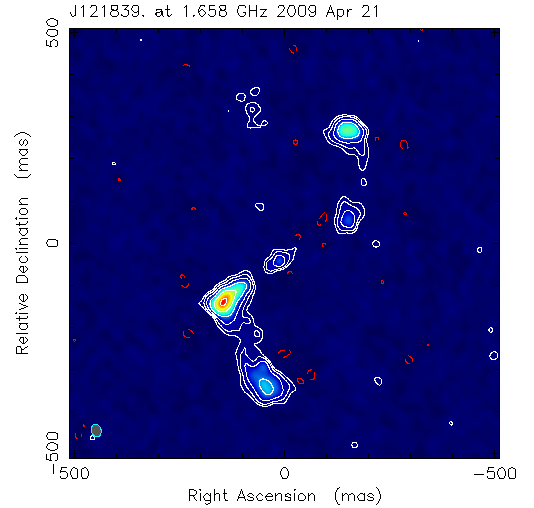Daily Image
02-03-2010A galaxy that was not there
| Submitter: | Zsolt Paragi |
| Description: | Astronomers identified an arc-like faint, optical source that appeared distorted. Similarly distorted (stretched) images are usually seen when a foreground massive galaxy bends the light rays as they travel in space, in the process we call gravitational lensing. However, there was no massive foreground object apparent in the optical images. They speculated that this could be the first example of a galaxy exclusively consisting of dark matter, a mysterious building block of our Universe which has not been identified so far. Ryan and collaborators (2008, ApJ 688, 43) found a nearby radio source, that could be related to this mysterious galaxy responsible for the gravitational lensing effect. Sandor Frey (FOMI Satellite Geodetic Observatory, Hungary) and colleagues - Zsolt Paragi and Bob Campbell (JIVE), Attila Moor (Konkoly Observatory, Hungary) observed this radio source at very high angular resolution using the European VLBI Network. They found evidence for an active galactic nucleus (AGN) in this system. AGNs are known to be powered by supermassive black holes. In this case the radio morphology is highly distorted, indicating strong interaction between the AGN ejecta and the surrounding medium, typical of young radio sources. Also evidenced by X-ray and optical/infrared data, this galaxy seems to be a normal but highly obscured system, where the optical light is imprisoned by a dense interstellar medium. J1218+2953, shown in the EVN image at 18cm wavelength, appears to host a hungry and steadily growing black hole which is in its early evolutionary phase. J1218+2953 received much attention because of its gravitational effect; there may be numerous other similar systems that have eluded discovery simply because they are extremely faint in the visible part of the spectrum. In deep surveys with future high-resolution radio instruments (e.g. WSRT/Apertif and later the SKA) we will find many more of them. This result was accepted for publication in Astronomy and Astrophysics. |
| Copyright: | S. Frey et al. |
| Tweet |  |
